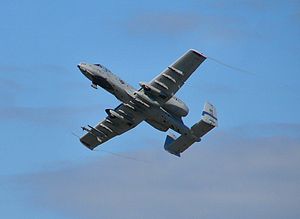45th Fighter Squadron
| 45th Fighter Squadron | |
|---|---|

|
|
| Active | 1940–1946; 1952–1958; 1962–1971; 1973–1994; 2009–present |
| Country |
|
| Branch |
|
| Role | Fighter |
| Part of | Air Combat Command |
| Garrison/HQ | Davis-Monthan Air Force Base |
| Engagements |
World War II Pearl Harbor Iwo Jima Vietnam War |
| Decorations |
Distinguished Unit Citation Air Force Outstanding Unit Award |
| Insignia | |
| 45th Fighter Sq emblem (approved 19 March 2010) |  |
| 45th Fighter Squadron emblem (approved 24 August 1944) |  |
The 45th Fighter Squadron is a United States Air Force Reserve unit. It is assigned to the Air Force Reserve Command's (AFRC) 924th Fighter Group and stationed at Davis-Monthan Air Force Base, Arizona. The squadron currently flies the Fairchild Republic A-10 Thunderbolt II.
The squadron trains A-10 Thunderbolt II pilots, operating and maintaining the aircraft of the 355th Fighter Wing, the regular A-10 unit at Davis Monthan. The A-10 formal training includes initial qualification in the airplane, transition training, instructor pilot upgrade training and a senior officer course.
The history of the 45th Fighter Squadron goes back to 22 November 1940, when the War Department constituted the 45th Pursuit Squadron (Fighter). The unit was activated at Wheeler Field, Hawaii on 1 December 1940, where it served as part of the 15th Pursuit Group in defense of Hawaii.
When the Japanese launched their surprise attack on Pearl Harbor on 7 December 1941, the 45th suffered heavy losses, as did the other squadrons in the 15th Group. Two-thirds of the Curtiss P-36 Hawk and Curtiss P-40 Warhawk aircraft at Wheeler Field were destroyed on the ground. Earlier, the planes had been stripped of ammunition and fuel, and taken out of their protective earthen revetments because of potential for sabotage in these protected but difficult-to-see areas. Parked in the open, the planes were easy targets for the Japanese pilots as they strafed and bombed the field.
Everyone on the ground scrambled for cover as the field was being hit, while at the same time pilots were trying to get their planes off the ground without too much success. However, Lieutenants George Welch and Kenneth Taylor, two pilots from the 47th Pursuit Squadron whose planes were at Haleiwa Field at the time, were able to get their Curtis P-40B Tomahawks into the air soon after the attack began. Although outnumbered, they still managed to shoot down six Japanese planes.
...
Wikipedia
